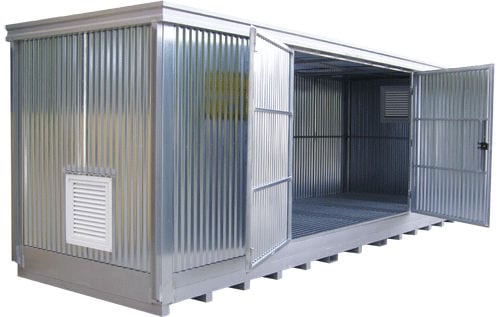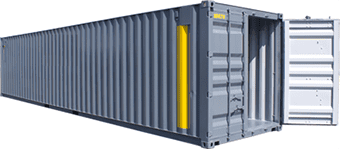
The Ultimate Guide to Protecting Building Materials with Conex Boxes
When working on a construction site, protecting materials from theft, weather damage, and general wear and tear is a top priority. Without proper storage, valuable materials like lumber, drywall, cement, and tools can be exposed to harsh conditions, leading to costly replacements and project delays.
One of the best solutions for secure and weatherproof storage is a Conex box—a durable steel shipping container designed to keep your materials safe and in top condition. But how do Conex boxes protect building materials, and why are they a smart investment for construction sites? In this guide, we’ll explore the materials Conex boxes are made from, how they provide protection, and the ways they help prevent theft and damage.
What Are Conex Boxes?
A Conex box is a steel shipping container originally designed for transporting goods across long distances. Over time, these containers have become a popular choice for construction sites, warehouses, and businesses needing secure, weatherproof storage solutions.
Conex boxes come in various sizes, with the most common being 20-foot and 40-foot containers. Their steel construction, lockable doors, and modular design make them ideal for protecting valuable materials and equipment.
What Are Conex Boxes Made From?
Understanding the materials used to build Conex boxes can help explain why they are such a reliable storage option. Unlike standard storage units, these containers are built to withstand extreme conditions and heavy use, making them ideal for construction sites that experience fluctuating weather and potential security concerns.
Corten Steel: Built for Strength and Durability
Conex boxes are primarily made from Corten steel, a high-strength, weather-resistant material designed to withstand harsh conditions. This type of steel is often referred to as “weathering steel” because it develops a protective rust-like coating over time, preventing further corrosion.
Unlike regular steel, Corten steel can endure exposure to rain, wind, and extreme temperatures without weakening. This makes Conex boxes a superior choice for protecting building materials from environmental damage.
Weatherproof Seals and Reinforced Doors
In addition to being built with Corten steel, Conex boxes feature:
- Rubber gasket seals on doors to prevent water from seeping inside
- Reinforced corners that provide structural integrity even under heavy loads
- Ventilation systems to reduce moisture buildup and prevent condensation
These design features ensure that materials stored inside remain dry, secure, and in optimal condition regardless of weather conditions.

How Conex Boxes Protect Building Materials from the Elements
Leaving materials exposed to the elements can lead to costly replacements and project delays. Whether it’s extreme heat, rain, snow, or humidity, these weather conditions can significantly impact the quality of building supplies. A Conex box provides a reliable barrier, ensuring that materials remain in top condition until they are needed.
Keeping Materials Dry and Preventing Water Damage
One of the biggest threats to building materials is moisture exposure. Rain, snow, and humidity can cause materials like lumber, drywall, and insulation to warp, grow mold, or deteriorate.
A properly sealed Conex box prevents water from reaching stored materials, reducing the risk of damage and ensuring that supplies stay in top condition until they’re ready to be used.
Shielding Materials from Extreme Temperatures
Construction projects often take place in hot, cold, or unpredictable climates. Without proper protection, materials left outside can crack, warp, or degrade due to fluctuating temperatures.
Conex boxes provide a controlled environment that minimizes exposure to extreme heat or cold. Some containers can even be insulated for extra protection, making them a great choice for sensitive materials.
Preventing UV Damage
Materials like plastic piping, adhesives, and certain types of lumber can degrade when exposed to direct sunlight for extended periods. Conex boxes provide full UV protection, keeping materials shaded and extending their lifespan.
How Conex Boxes Protect Against Theft and Vandalism
Construction sites often struggle with theft and unauthorized access, especially when expensive tools and materials are left unprotected. A Conex box acts as a secure storage solution, helping deter potential thieves and keeping your job site safe from loss.
Heavy-Duty Steel Construction
Unlike traditional wooden or fabric storage sheds, a Conex box is made of thick, reinforced steel, making it nearly impossible for thieves to break into using standard tools.
Their solid structure and tamper-resistant design make them one of the most secure storage solutions available for construction sites.
Locking Mechanisms for Added Security
To further prevent unauthorized access, Conex boxes can be equipped with:
- Heavy-duty padlocks
- Steel lockboxes to cover and protect locks from tampering
- Electronic keypads or smart locks for high-security sites
These security measures ensure that only authorized personnel have access to valuable materials and equipment.
Deterring Trespassers and Vandalism
Construction sites are common targets for vandalism, especially when they are unattended overnight. A locked and secured Conex box acts as a deterrent, making it difficult for trespassers to access materials or cause damage.

Additional Ways to Optimize a Conex Box for Material Protection
While Conex boxes provide excellent storage on their own, making a few modifications can help further improve organization and efficiency on the job site. From shelving systems to climate control, these upgrades make it easier to access and protect important materials.
Installing Shelving and Racking Systems
To maximize space and keep materials organized, many construction teams install shelving and racking systems inside their Conex boxes. This makes it easy to store smaller tools, fasteners, and delicate materials in a way that minimizes the risk of damage.
Using Climate Control for Temperature-Sensitive Materials
For projects requiring temperature-sensitive materials, a Conex box can be insulated and outfitted with heating or cooling systems to maintain a stable internal climate. This is especially useful for:
- Paints and adhesives that can harden or separate in extreme cold
- Plaster and drywall materials that absorb moisture easily
- Electronics and power tools that can be damaged by humidity
Adding Lighting for Visibility and Safety
Since many construction crews work early mornings or late evenings, adding interior lighting to a Conex box makes it easier to access materials safely. LED strip lighting or battery-powered lights are simple and effective solutions for improving visibility.
Why Conex Boxes Are a Smart Investment for Construction Sites
Investing in a Conex box for job site storage can provide long-term benefits. They are designed to be durable, portable, and versatile, offering a cost-effective alternative to building permanent storage structures.
Cost-Effective Storage Solution
Compared to building permanent storage structures, renting or buying a Conex box is far more affordable. The durability and reusability of these containers make them a cost-effective storage option for long-term and short-term projects alike.
Portable and Easy to Relocate
Construction projects often move from one site to another. Unlike permanent storage buildings, Conex boxes can be easily transported to a new location, making them ideal for contractors working on multiple job sites.
Versatility for Multiple Uses
Beyond material storage, Conex boxes can be converted into:
- Mobile workshops
- On-site office spaces
- Break rooms for construction crews
Their adaptability makes them a valuable asset for any construction project.

How to Choose the Right Conex Box for Your Job Site
Selecting the right Conex box for your construction site depends on a few key factors, including size, condition, and security features. Carefully evaluating your needs before purchasing or renting a container ensures you get the best solution for your job site.
Determine the Right Size
The most common sizes for Conex boxes are:
- 20-Foot Container – Ideal for small to medium-sized storage needs
- 40-Foot Container – Best for large projects requiring bulk material storage
- Custom Sizes – Some providers offer modified containers for specific job site needs
Consider New vs. Used Conex Boxes
- New Conex Boxes offer maximum durability and are in pristine condition but can be more expensive.
- Used Conex Boxes are more affordable and still provide excellent security, especially if inspected for wear and tear before purchase.
Check for Ventilation and Security Features
If your materials are sensitive to humidity, look for a ventilated Conex box. If theft is a major concern, opt for reinforced locks and additional security upgrades.
A Conex box is one of the most effective storage solutions for protecting building materials on a construction site. With heavy-duty steel construction, weatherproof seals, and advanced security features, these containers provide a safe, durable, and cost-effective way to store materials, tools, and equipment.
Whether you’re looking to prevent theft, shield materials from harsh weather, or create an organized job site, a Conex box is an excellent investment. By choosing the right size, optimizing the interior for efficiency, and securing it with proper locking mechanisms, you can ensure that your materials remain protected and in perfect condition throughout your entire project.
